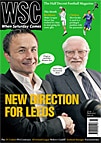 Julius Bergmann reports on where the Germans stand on terracing
Julius Bergmann reports on where the Germans stand on terracing
The last official report into the possibility of allowing standing areas in UK stadiums came in 2001, when then Sports Minister Kate Hoey dispatched the Football Licensing Authority on a fact-finding mission to Germany. Not only were new stadiums being constructed for the World Cup, Germany was then, and remains, the only major European footballing nation where standing areas are allowed in top-flight arenas.
“For a lot of our fans, standing areas are a prerequisite for coming into the stadium,” says Jörg Wolf, spokesman for Hamburg SV. This is a prerequisite German clubs and stadium operators gladly accede to. “Standing places are important for us, both to meet the fans’ requirements and also for the fantastic atmosphere they help create,” adds Christine Vissers from the Commerz-Bank Arena in Frankfurt.
Fans who went to England’s World Cup match against Paraguay in Frankfurt won’t, however, have seen much of the standing area. In order to accommodate the fans’ desire as well as UEFA and FIFA’s requirement for all-seat stadiums, removable seating is used. Not that it makes much difference. “We can’t force the fans to sit and in many blocks the fans stand even when the seats are in place,” observe the operators of the Munich Allianz Arena, somewhat despondently. For the ultras from “Shickeria München”, just as fans in Bremen, Magdeburg or Hamburg, sitting during a match simply doesn’t come into it.
UEFA justify the “all-seat” regulations in the main on safety grounds. This is “absolute nonsense” according to Professor Gunter Pilz from the Institute of Sports Science at Hanover University. A leading expert on fan culture and football violence, Professor Pilz argues that there is no evidence that all-seat stadiums are intrinsically safer than those with standing areas. Additionally, for Professor Pilz, fans standing in seated areas present a much higher risk to themselves and others than fans in a designated standing area. For the fans’ representatives the reasoning is equally opaque. “At every Bundesliga match the standing areas are there and there are no problems, why should it be any different at international matches?” asks Johannes Stender from the pressure group Bundnis Aktiv Fussball Fans.
The most vocal in expressing their concerns in regard to standing areas are the emergency services. Sudden and violent crowd movement, they fear, can lead to dangerous situations. After any incident, it is more difficult to assess the number of injured in a standing area and rescuers can more easily lose their orientation, both of which can seriously delay assisting victims. However, despite these concerns, the majority are happy that under certain conditions standing areas are no more dangerous than sitting. These are where a clear emergency plan exists, all parties know their responsibilities and, most important, the stewards ensure the rules are adhered to and defined emergency routes are kept clear.
For German fans, standing blocks aren’t just about tradition and emotion. In the context of modern football they also see standing blocks as providing an important social and integration function, in an ever more fractured society. The standing areas also allow fans the chance to express their emotions creatively; the flag shows and match-long chanting simply could not be organised in a seating area. “UEFA should try to see the potential in standing blocks, not just try to get rid of them,” urges Stender.
Following Hillsborough, many Germans felt that the UK authorities should have taken steps to create safer terracing, rather than simply abolishing the standing areas. Where once Germans watched British football with wonder, there is now widespread dismay at the decline in fan culture. “Many of our fans have become increasingly disappointed from the atmosphere at matches in England,” says Joachim Ranau from the Hamburg Fan Project, “and the all-seater stadiums are almost always to blame.” The time is long overdue for an open and honest discussion on Lord Taylor’s recommendations concerning standing areas. The experiences of fans, rescue services, clubs and stadium operators in Germany could prove invaluable to such a debate.
From WSC 241 March 2007. What was happening this month